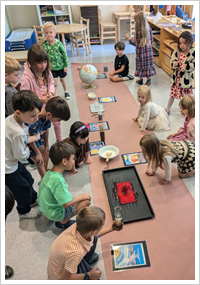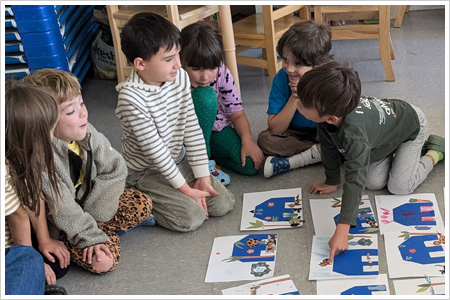Lower Elementary
As of the 2023-2024 Academic Year, Carrig Montessori School has expanded to the elementary grades! In our mixed-age, first through third grade class we continue to place a strong emphasis on grace and courtesy, care of the environment, self-directed work cycles and hands-on learning through didactic materials, however it is during this second plane of development that we also have the exciting opportunity to introduce "big picture" concepts that are more abstract in nature.
The Five Great Stories
 Montessori elementary curriculum is intentionally designed as a spiral curriculum with concepts being introduced and reintroduced at increasingly deeper and more complex levels, with focus on the interrelated nature of each subject area. Children between ages six to nine have a heightened interest in understanding the reasoning behind things, which is nourished through Montessori's Five Great Lessons/Stories, also known as Cosmic Education. The function of these stories is to give children the groundwork to understand the "big picture" and form the basis of the spiral curriculum from which more detailed exploration in science, history, language, geography, mathematics and art springs forth. The Five Great Stories are as follows:
Montessori elementary curriculum is intentionally designed as a spiral curriculum with concepts being introduced and reintroduced at increasingly deeper and more complex levels, with focus on the interrelated nature of each subject area. Children between ages six to nine have a heightened interest in understanding the reasoning behind things, which is nourished through Montessori's Five Great Lessons/Stories, also known as Cosmic Education. The function of these stories is to give children the groundwork to understand the "big picture" and form the basis of the spiral curriculum from which more detailed exploration in science, history, language, geography, mathematics and art springs forth. The Five Great Stories are as follows:
The Creation of the Universe: The first of all of the Great Stories is an introduction to the vastness in both time and space of our universe. We come to understand that our sun is only a single star within the galaxy of the Milky Way. This begins our study of all of the planets in our solar system as well as a study of the earth's layers and atmosphere. It is through these studies that we begin to learn about volcanoes and the water cycle, both of which demonstrate how matter can shift from solid to liquid to gas. The Creation of the Universe allows us to introduce a variety of scientific studies including physics, chemistry, geology, meteorology and astronomy.
The Coming of Life: Through this story we explore the timeline of the geological eras (Paleozoic, Mesozoic and Cenozoic). Students look at the beginning of invertebrates, followed by fish and plants, then amphibians, reptiles and birds and mammals. This becomes the basis of lessons in zoology, botany and the study of symbiotic relationships in nature and habitats.
The Story of Humans: This story follows a timeline of early humans from prehistoric times through the emergence of ancient civilizations. Studying many civilizations across history and across geographic regions gives children the opportunity to compare cultures and form a greater understanding of how climate and topography, which is introduced in the first of the Great Stories, has shaped culture throughout history.
Communication and Writing: This story describes the origins of written language beginning with Egyptian hieroglyphics and American Indian picture writing. As with all of the Great Stories, we then expound to a timeline of language and the contributions from cultures throughout history including Hebrews, Greeks and Romans. Through this study we begin to look at our own written language through grammar as well as word origins and the study of prefixes and suffixes. It is through the Great Story of Communication and Writing that we explore poetry, plays, short stories, fiction and nonfiction.
The Story of Numbers: This story explains how our use of numbers came to be through the human development of an agreed upon system that would convey measurement. Our timeline here begins with the Sumerians and Babylonians who had a number system based on 60, which we come to learn is what our time system is still based on today. We will then study numerical contributions throughout history, including the decimal system and the introduction of zero and negative numbers. These studies will be the basis for mathematical exploration throughout the Lower Elementary Math Curriculum.

These Five Great Stories are revisited throughout the three year cycle of 1st through 3rd grade Lower Elementary Curriculum. Each year students move to deeper levels of understanding. Below you'll find a table of our learning standards for Lower Elementary:
| Mathematics | Language Arts | Science |
|---|---|---|
| Place value up to 10,000 | Continued work on Reading Fluency | Matter: solid, liquid and gas |
| Dynamic Addition and Multiplication | Reading Comprehension | Vertebrates and Invertebrates |
| Subtraction and Division | Grammar: Eight Parts of Speech | Research of Animals and their Habitats |
| Measurement | Punctuation and Capitalization | Botany Nomenclature |
| Money | Handwriting | Gardening |
| Telling Time | Fiction, Non-Fiction, Poetry, Plays and Short Stories | Cooking |
| Classification of Triangles | Synonyms and Antonyms | Solar System: Identifying Planets and the Characteristics |
| Classification of Quadrilaterals | Prefixes and Suffixes | Layers of the Earth |
| Introduction to Fractions | The Water Cycle |
| Art | Music | Social Studies |
|---|---|---|
| Foreground, Middleground and Background in 2D Art | Changing Dynamics and Tempo | Timeline of History |
| Qualities of Color | Sing and Play with Accompaniment | Personal Timeline of Each Student |
| Sculpture Inspired by Pre-Columbian Artifacts | Body Percussion and Unpitched Percussion Instruments (rhythm sticks, drums, castanets, bells) | First Civilizations |
| Textile Study Inspired by American Indian Culture | Introduction to Melodic Instruments (glockenspiels, xylophones) | Geological Eras |
| Portrait Study Inspired by Post-Impressionist and Modern Artists | Solo, duet and choral singing | Flags and Countries |
| Embroidery | Spring Concert | States and Capitals |
| Cultural Celebrations from Around the World, with Emphasis on Cultures that our Representative of our Student Population |
Hours and Tuition
2025-2026 Academic Year Tuition (September, 2025 - June, 2026)
| Program | Tuition |
|---|---|
| Standard Day (8:30am - 3pm, Monday - Friday) | $22,500 |
| Extended Day (8:30am - 6pm, Monday - Friday) | $27,500 |
Payment Schedule
A non-refundable holding fee of $2,800 is due upon acceptance into the program. Tuition for the academic year will be divided into 4 equal payments due May 1st, August 1st, November 1st, and February 1st. Holding fees will be applied to the payment due February 1st, 2026.